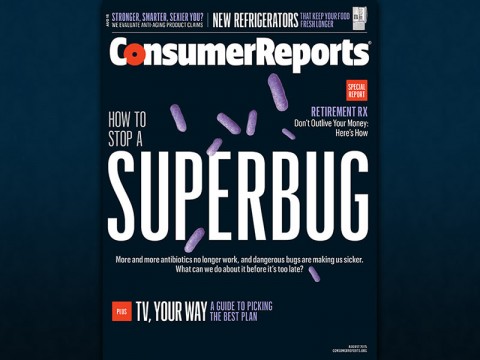Consumer Reports says Antibiotic-Resistant Superbugs are the Health Crisis of This Generation
June 27, 2015

Yonkers, NY – Decades of inaction to curb the overuse of life-saving antibiotics by physicians, dentists, patients, and farmers has created hard-to-treat “superbugs” that are spreading and growing stronger, with dire consequences, according to Consumer Reports, the world’s largest and most trusted nonprofit consumer organization.
The U.S. Centers for Disease Control and Prevention (CDC) says that the unrestrained use of antibiotics sickens at least 2.25 million Americans each year and kills another 37,000 people.

Superbugs
“The Rise of Superbugs” is featured on ConsumerReports.org/superbugs and in the August issue of Consumer Reports magazine and is the first report in a three-part investigative series focused on America’s antibiotic crisis.
This introductory piece explains how the overuse and misuse of antibiotics is leading to the strengthening and spread of dangerous infections that are becoming resistant to these drugs. For example, resistant bacteria like MRSA were once confined to hospitals, but have now spread to otherwise healthy people in the community.
The remaining installments will examine the presence of superbugs in America’s hospitals and the role antibiotics play in the U.S. meat supply.
“The emergence of antibiotic-resistant superbugs is a major threat to the health and well-being of millions of Americans,” said Lisa Gill, prescription drugs editor, Consumer Reports. “The problem is fixable, but we must act quickly and work together to change our behaviors to preserve the effectiveness of these life-saving drugs.”
A new nationally representative survey from Consumer Reports shows poor awareness among Americans about antibiotic resistance and widespread misinformation about its causes, with 41 percent of adults saying they are unaware of antibiotic resistance.
In addition, the overuse of antibiotics can kill “good” bacteria, leaving people susceptible to other difficult-to-treat bacterial infections, like C. difficile.
Officials from the CDC, World Health Organization, and European Union have all sounded the alarm, calling the rise of resistant bacteria one of the world’s most serious health crises.
Consumer Reports says the crisis is compounded because the pipeline for new antibiotics has slowed to a trickle, with many broad-spectrum antibiotics introduced some 30 years ago. “We absolutely need new antibiotics,” said Lisa McGiffert, director of Consumer Reports’ Safe Patient Project. “But we have to make sure that we don’t lower the bar on standards for drug approval and that all new antibiotics have met pre-market assessments for safety and efficacy.”
Consumer Reports recommends specific steps for reducing the use of antibiotics and curbing the development of drug-resistant bacteria, including:
- Patients should think twice about the need for antibiotics and should not ask doctors to prescribe them. Consumer Reports’ survey found that one out of every five people who had received a prescription for an antibiotic in the last year said they had asked their health practitioner to write it.
- Doctors and dentists must stop over-prescribing antibiotics when they aren’t absolutely necessary. The CDC estimates that up to half of all antibiotic prescriptions are written for inappropriate uses, or for things they don’t work against, such as for colds and the flu.
- Patients should request targeted drugs. When possible, your doctor should order cultures to identify the bacteria that caused your infection and prescribe a drug that targets that bug.
- Doctors should reserve so-called “broad-spectrum” antibiotics, such as ciprofloxacin, ceftriaxone, and levofloxacin for hard-to-treat infections. These drugs attack multiple bacteria types at once and are more likely to breed resistant bacteria and wipe out protective bacteria in the body.
- Consumers should use antibiotic creams sparingly. Even antibiotics applied to the skin can lead to resistant bacteria. Use over-the-counter ointments containing bacitracin and neomycin only if dirt remains after cleaning with soap and water.
- Everyone should avoid infections in the first place. That means staying up to date on vaccinations. And it means washing hands thoroughly and regularly, especially before preparing or eating food, before and after treating a cut or wound, and after using the bathroom, sneezing, coughing, and handling garbage. Plain soap and water is best. Avoid antibacterial hand soaps and cleaners, which may promote resistance.
Consumer Reports is committed to help wipe out the antibiotic-resistant bacteria or “superbugs” through coordinating among all of the organization’s broad resources and channels.
As part of this initiative, Consumer Reports will participate in this week’s Spotlight Health, a segment of the Aspen Ideas Festival; Board Chair Diane Archer will moderate a panel on how to curb antibiotic overuse in the U.S. and around the world. And, earlier this month Consumer Reports’ President and CEO Marta Tellado was invited to participate in the White House Forum on Antibiotic Stewardship.
In addition, Consumer Reports, through its participation in the Choosing Wisely initiative, is collaborating with seven U.S. healthcare organizations to focus on reducing the inappropriate use of antibiotics for viral infections by at least 20 percent within three years.
Consumers Reports has created a special page at ConsumerReports.org/superbugsfeaturing a wide range of information on superbugs and antibiotic resistance including videos, news articles, and social conversation. Consumers can follow the conversation on Twitter at #SlamSuperbugs.
About Consumer Reports
Consumer Reports is the world’s largest and most trusted nonprofit, consumer organization working to improve the lives of consumers by driving marketplace change. Founded in 1936, Consumer Reports has achieved substantial gains for consumers on health reform, food and product safety, financial reform, and other issues.
The organization has advanced important policies to cut hospital-acquired infections, prohibit predatory lending practices and combat dangerous toxins in food. Consumer Reports tests and rates thousands of products and services in its 50-plus labs, state-of-the-art auto test center and consumer research center.
Consumers Union, a division of Consumer Reports, works for pro-consumer laws and regulations in Washington, D.C., the states, and in the marketplace. With more than eight million subscribers to its flagship magazine, website and other publications, Consumer Reports accepts no advertising, payment or other support from the companies whose products it evaluates.
No comments:
Post a Comment